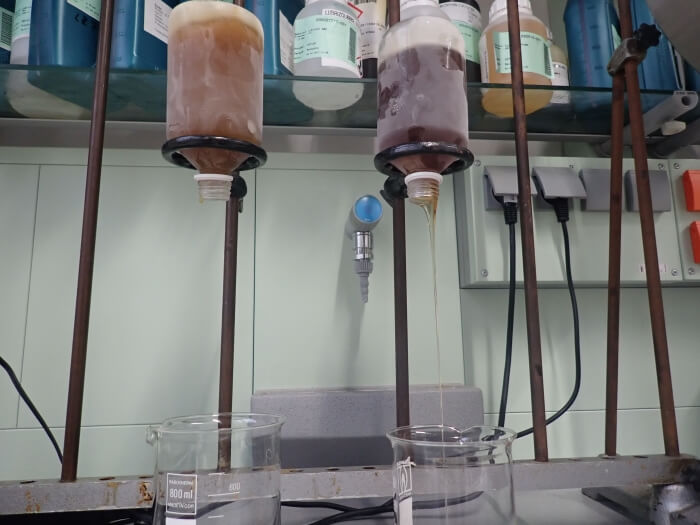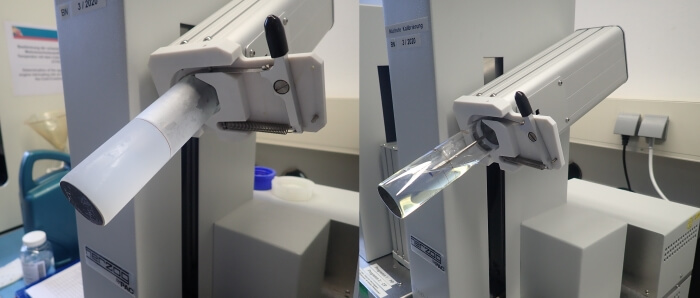


What is the pour point for oil?
The term pour point can also be described with flow point or the cold behaviour of oil. The pour point describes the temperature at which the oil is still fluid and applicable under defined test conditions. Depending on the type of lubricant, the pour point lies between approx. -65 °C to -10 °C. When oil freezes, the paraffins crystallize and cross-link. The oil becomes milky and cloudy. The viscosity of the oil increases until it becomes a solid, waxy mass. When the oil solidifies, the lubricating properties fail because the oil is no longer optimally distributed to the lubrication points.
Additives such as pour point improvers (paraffin-alkylated naphthalenes and phenols as well as polymethacrylates) can additionally reduce the pour point of a lubricant. These delay the contraction of the paraffin crystals.
The term "pour point" is often mistakenly equated with the term "solidification point". However, the solidification point describes the temperature that an oil must reach in order to solidify completely. This is about 3-5 °C below the pour point.

The oil on the left has already reached the solidification point because it no longer runs out of the bottle. The oil on the right is still flowing despite the frost.
How is the pour point of oil determined?
The oil is cooled down slowly and gradually (3 °C steps) in a glass container according to ISO 3016. After each stage, the oil sample is tilted horizontally. As long as the oil is still flowing, the sample is further cooled down. Only when the oil no longer moves the pour point is determined. The pour point is then the second to last temperature step, since the last is noted as the solidification point.

At what temperatures is the pour point of oil reached?
The pour point of oil allows only limited statements about its behaviour at cold temperatures. The actual viscosity at certain temperatures is a better indication of the usability of the oil. Classic automotive engine oils operate at a limit pump temperature. This indicates the temperature limit at which the oil must still be pumpable. Multigrade oils with SAE class 0W can be pumped down to -40 °C, for example.
Automotive transmission oils prescribe limiting viscosities of 150,000 mPa*s, which a transmission oil must not exceed at a certain temperature. Transmission oil of the SAE class 70W, for example, is still flowable down to -55°C.
In the case of industrial oils, the pour point information is always noted in the product data sheets. Various special oils have a pour point down to -65 °C. However, the recommended range of use is usually slightly higher and should not be exhausted to the pour point.
If an oil is stored once below the pour point, it can usually be thawed and reused by selective heating. Water-miscible cooling lubricants, which should no longer be used after extreme frost, are an exception.

Pourpoint comparison between grease and oil
Lubricating greases can be similarly temperature resistant to oils, as they are also characterized by the properties of the base oil. Additives can also lower the pour point even more. However, for lubricating greases no pour point is determined but operating temperatures are indicated which can also reach down to - 60 °C. This means that the greases can also be used in cold stores and outdoor facilities. An example of this is the Longlife Grease HS 2.
Examples of lubricants with good cold resistance from ADDINOL
ADDINOL offers many special oils, which have a particularly low pour point to be able to cope with applications in cold climates or cold stores. We have collected some examples of our oils which have a low pour point.
| ADDINOL oil | Pour point | Field of application |
| MULTI TRANSMISSION FLUID 75 W 80 | -50 °C | Transmission oil for passenger cars |
| ADDINOL SUPERIOR 030 | -55 °C | Engine oil for passenger cars |
| ADDINOL HYDRAULIC OIL HVLP 15 | -57 °C | Hydraulic oil |
| ADDINOL ARCTIC FLUID 5606 | -64 °C | Hydraulic oil |
Contact
